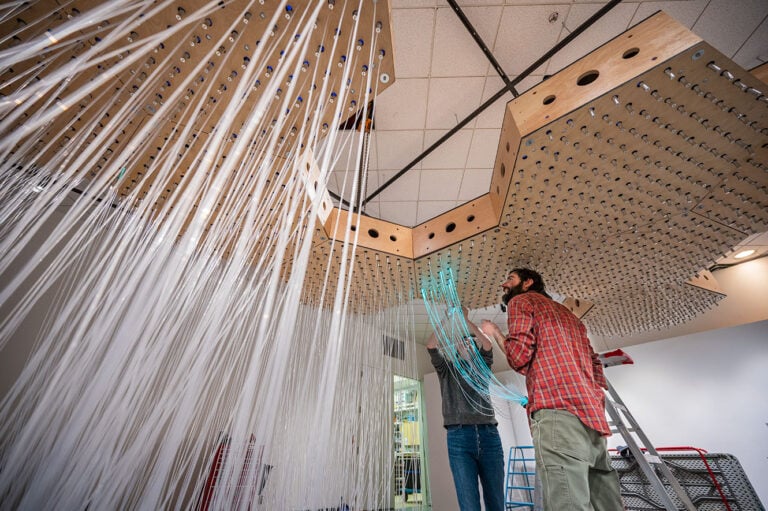By Amy Kenny
Ann Smith and Brian Walker sit side by side in the shade of the trees on their Long Lake property. The branches and a breeze coming off the water are the only things tempering the May heat as they talk about their upcoming joint show at the Yukon Arts Centre.
In some ways, the couple couldn’t be more opposite. She speaks softly and slowly, making the odd gesture, but otherwise sitting still. His heels jiggle non-stop on the rung of his lawn chair. The squeak of them is almost louder than his wife’s voice. When it’s his turn to speak, the words tumble out in a rush. Where the two are similar is that they’re both eager to talk about the other’s work.
Smith is a weaver. Walker is a carver. Both work from here, the Long Lake property where Smith’s parents used to run a trapline, from Grey Mountain to the Takhini River. Smith weaves in their house. Walker carves in a 1,000 square-foot workshop built for him by one of the couple’s sons.
Though they work in different mediums, they’re drawn to similar subject matter, which is how they ended up with a joint show at YAC in June, called Echo of the Spirit Voice. The title comes from one of Smith’s patterns, called Echo of the Spirit Voice of the Shadows of the Trees Reflected in Water.
The pattern, like all Ravenstail patterns (the style Smith works in) is tight and geometric. It’s meticulous, with sharp lines and contrasts. Smith feels strongly about teaching what she knows of the art form, which is thought to be more than 1,500 years old. It evolved into the Chilkat style and, says Smith, has come close to dying out in the past. She only learned to do it in 1990, when there was a class offered at Yukon College. Smith, a member of the Wolf Clan, with Tlingit and Tutchone ancestry, endorsed the class as then-chief of the Kwanlin Dün First Nation, but it was Walker who convinced her to attend it.
“I stayed that day and from there it took about a year and then it just took right off,” she says. She attended retreats all over the west coast – in B.C., the Yukon and Alaska – learning with and from other aboriginal women.
“To me, it brought me a peace of mind. It slowed me down to the world because, you know, we all get into this rush mode and this slowed me right down because you can’t go fast.”
Now, in addition to preparing work for exhibitions around the world (her son danced in one of her robes during the 2010 Olympics in Vancouver and she was commissioned to craft a piece for His Royal Highness the Prince of Wales), Smith teaches others during events such as the Adäka Cultural Festival.
Walker also participates in the festival, having been chosen in 2014 to be part of the festival’s Journey Project, which brought together senior carvers from B.C., Alaska, the Yukon and New Zealand.
Walker was curious about carving from an early age. At 12, after moving west from Montreal with his family, he lived near Haida artist Bill Reid. The two developed a sort of mentor/mentee relationship, where Reid put Walker to work sweeping Reid’s carving shed and taught him about totem poles. It sparked in Walker a lifelong interest in First Nations culture that only grew stronger when he moved to the Yukon in the 1960s.
Here, he began studying with artists including Gitxsan jeweler Philip Janze and woodcarver Dempsey Bob, and collaborating with Yukon artists Keith Wolfe Smarch and Mark Porter.
Today, Walker’s workshop is full of pieces at every stage of creation. There are flat sheets of copper, measuring eight feet by three feet. There are big copper bowls, recently rounded. There are half-hammered ceremonial masks, hollowed and filled with pitch, the resin Walker uses to provide some resistance to his hammering.
He favours traditional tools and techniques – rivets and hammers over brazing and welding – and works with the ancient art of repousée and chasing. One of the pieces he’s working on for the show uses a design from one of Smith’s weavings, called The Shadow of the Raven’s Tail.
Walker says the names capture what their work is about.
“The artwork really reflects the spirit of the land and what’s there,” he says. “Sometimes you go to old places where people used to live and you can just feel those kinds of things. Those kind of echoes that are passed on to use somehow.”
He looks around the property and smiles. Smith brought him here to meet her parents the first day she met Walker. It was June 21, 1975. The summer solstice. Her dad called him a greenhorn. They’ve been together ever since.
“And sometimes they’re passed on in dreams,” says Smith, smiling and nodding.
Echo of the Spirit Voice, along with Goodbye by Sonja Kelliher-Combs of Alaska, runs at the Yukon Arts Centre from May 30 to August 24. Admission is free. The opening reception takes place May 30, from 5:30 pm to 7:30 pm
Photos courtesy of Yukon Government



